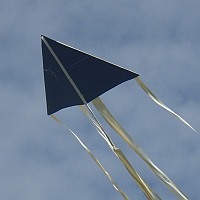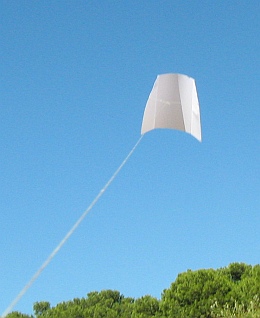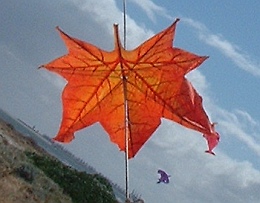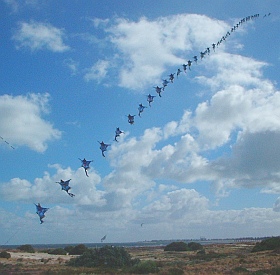- Home Page
- Accessories
- Kite Paper
Kite Paper
What's Best for Making Kites?
Kite paper can be just about any kind of paper, but making kites fly really well requires more than just ordinary writing paper. The main properties required are strength and light weight. Gift wrap's not bad. Having said that, I'm going to touch on the whole variety of paper used in modern kite-making.
 MBK Paper Delta
MBK Paper DeltaModern paper kites cover the whole range, from super-quick designs that barely fly, through to carefully crafted traditional kites that shoot up high on the barest puff of wind.
Many years ago, the very first kite I ever bought from a shop was an Indian design. Made from colored tissue and bamboo, it was an exceptionally good flyer over a wide range of wind strengths!
So, in general, what kinds of kites are made with paper sails anyway?
A few moments with my thinking cap on resulted in three very broad categories, to answer that question. Curiously, my MBK Paper Series doesn't really belong in any of them! But never mind.
One category is covered in each of the sections further down this page.
On this site, there's more kite-making info than you can poke a stick at :-)
Want to know the most convenient way of using it all?
The Big MBK E-book Bundle is a collection of downloads—printable PDF files which provide step-by-step instructions for many kites large and small.
Every kite in every MBK series.
Western Kid's Kites
Going back to at least the middle of the 1900s, kites for children were available in shops. The bulk of these used paper for sail material. Although shop-bought kites now use mainly plastic or nylon, kite-making workshops for kids still often feature paper or tissue for sails.
The simple diamond is a common choice, since it is so easy to
make and is such a reliable flyer. The longer the tail, the more
reliable :-) Rokkakus are often made of paper too. Another choice for
the more artistically minded is butterfly kites, which tend to be pale
imitations of the real flying art-works from China.
The kite paper
Here, the range of options is pretty wide. For a kite with a frame, such as a diamond or rok, almost anything works to a degree. As long as it is not so porous that it lets air through! A perimeter line goes around the tips of the spars, and the paper or tissue is made slightly oversize. Hence, the sail can be folded over and pasted down around the edges to help keep it flat and resist tearing.
Let's see, bearing in mind lightness and porosity, you could try:
- gift-wrapping paper
- rice paper
- origami paper
- writing paper
- newspaper! (the poor man's sail material)
This is not to mention a host of other materials that are not wood products, such as Mylar and Cellophane.
Minimum Kites
 A single sheet of copier paper
A single sheet of copier paperI'm not sure if there is such a term really, but it seemed appropriate enough. Some kite designs these days are meant for absolute minimum everything. Minimum
- complexity
- construction time
- materials cost
- kite-maker ability!
Not surprisingly, this approach tends to result in ... minimum performance too, but that doesn't stop loads of people enjoying the thrill of making something themselves and then seeing it fly! Long tails are often required to keep the kites stable, and they won't fly at all in light winds since the paper and tape can be rather heavy. Of course, kids can always tow them around to make them fly.
The majority of these kites probably fall into two categories—sleds and paper planes. Yes, one of the most well known of these does
look somewhat like a paper plane, except that a bamboo skewer or straw
is taped across it to function as a horizontal spar. Due to the small
size of these designs, most of them can be flown on sewing-thread
lines.
The kite paper
What's the most commonly available kind of paper on the planet?
A4 or Letter-sized sheets of course, as commonly used for photocopying. These are too heavy for great
performance but can be coaxed
to fly as proven by the kite designs already mentioned. In fact, the
picture up there is our Minimum Sled design. It's crafted from a single sheet
of A4 and precious little else!
Any reasonably thin and stiff type of paper could be tried and should work to a degree. For example, wrapping paper, which could have some great patterns preprinted on it. However, flimsy tissue or crepe paper would be less suitable.
Traditional Kites
 Exquisite "leaf" in tissue and bamboo
Exquisite "leaf" in tissue and bambooAlthough kite-making tradition goes back 100s or even 1000s of years in various locations, modern kite-makers in Asia are still churning out large volumes of paper kites which are very faithful to ancient traditions. Often, the kite paper and techniques used are virtually unchanged.
China, India, and Japan have kite making entwined through their cultures.
The major sail material for traditional-style kites is paper or tissue.
You can see this in the closeup photo of a Taiwanese leaf kite. It's a pretty good representation of a leaf don't you think?
And
in the next photo you can see the whole train of traditional Taiwanese
kites that we saw at the Adelaide Kite Festival one year. They are tissue paper
and bamboo; all are attached to a single natural-material flying line.
Most
of these kites are superb flyers. I will never forget my Indian kite
which I bought as a teenager. It was my first experience of a
high-performance single-liner.
 Tissue and bamboo kite train
Tissue and bamboo kite trainThe kite paper
Apparently, the art of hand-making extremely strong but light kite paper originated in China before finding its way to Japan. In Japan, this "washi" paper is often created from the bark of mulberry trees.
The final product is laminated from thin layers of fiber, one on
top of another. It's the long length of the fibers which gives the extra strength. Commercially-made paper created from wood pulp just can't compare!
Indian fighter kites are traditionally made from tissue paper and bamboo strips, although modern versions often use such materials as Mylar or plastic sheet as well.
Modern recreations of these kites work adequately well with tissue sheets from newsagents or gift shops. As long as the tissue has relatively low thickness, weight, and stretch, it is fine. However, the Indian makers of the best fighters have their own special sources for tissue paper.
Have fun experimenting with all kinds of kite paper! I might try a big newspaper kite myself one day. I'm curious!
As mentioned earlier, there's more kite-making on this site than you can poke a stick at :-)
Want to know the most convenient way of using it all?
The Big MBK E-book Bundle is a collection of downloads—printable PDF files which provide step-by-step instructions for many kites large and small.
Every kite in every MBK series.
